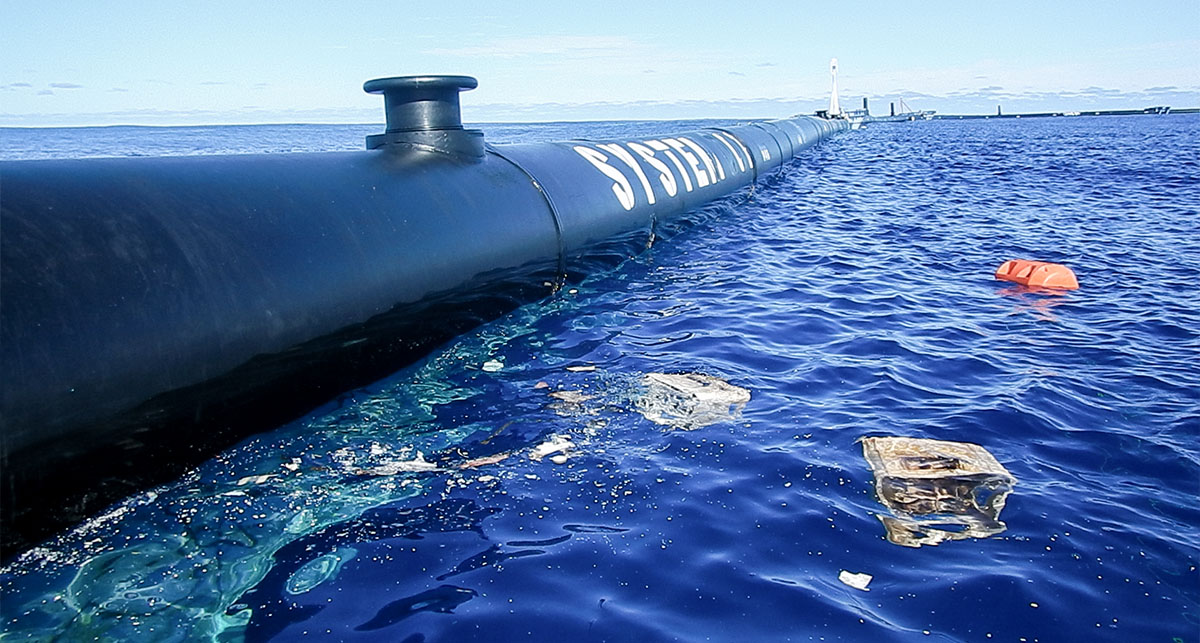The Ocean Cleanup project is a passive drift system that aims to collect larger marine plastics that have been accumulating in specific areas of the world’s oceans. When you consider the size of these accumulations, you’ll begin to understand why this is viewed as a crisis that is on the verge of spinning out of control.
For example, the North Pacific Gyre, more regrettably known as the Great Pacific Garbage Patch, covers a surface area of 1.6 million square kilometers and contains marine plastics in the amount of 1.8 trillion pieces, weighing approximately 80,000 tons (The Ocean Cleanup 2018). Take a moment to let that sink in – 80,000 tons. That’s a lot of plastic that needs to be removed from a sensitive ecosystem.
The design of the cleanup system is deceptively simple. The Ocean Cleanup deploys a full passive drift system, 600 meters in length. The system is designed to drift forward on surface currents and wind, corralling the captured plastic in front of the floating barrier. The curvature of the passive drift system will allow for the accumulation of marine plastics by naturally funneling the materials into the center of the structure.
Not doing damage to the environment, and not harming any wildlife was a major consideration of the project and as a precautionary measure, The Ocean Cleanup took a Protected Species Observer onboard with each crew to aid in the prevention of ship strikes or entanglements of marine wildlife on its missions in the Pacific Ocean. MVI provided protected species monitoring services for the first Pacific tow test, conducted offshore San Francisco, CA from May 19, 2018 to June 4, 2018.
MVI’s Protected Species Program Manager, Brittiny Bennett, was the trained Protected Species Observer (PSO) on board the towing vessel, Westar Scorpius. Bennett was on board to monitor specifically for marine mammals and sea turtles in the vicinity of the vessel and tow system. Data was collected on the position, heading, physical description, behavior and distance from the vessel and tow system for each sighting.
During the project, Brittiny noted an abundance of wildlife, none of which was observed to be in any risk of becoming entangled in the system in tow, or wandering into the path of the Westar Scorpius. Outside of the Greater Farollones National Marine Sanctuary, great numbers of humpbacks and some gray whales were observed. Further out at sea, bow riding Pacific white-sided dolphins and Dall’s porpoises made for some interesting encounters. Fur seals were regularly observed exhibiting active behaviors, resting at the surface and feeding in the vicinity of the vessel. At one point, a humpback mother and calf were observed. The calf was actively rolling and displaying the pectoral flippers while traveling alongside the mother. Outside of the Monterey Bay National Marine Sanctuary, a massive blue whale captivated the crew covering a great distance with each stroke of the tail flukes.
The tow testing proceeded without incident or harm to any mammals or marine wildlife. Bennett confirmed that “there were no ship strikes, entanglements or observable negative behavioral changes as a result of the vessel or tow system observed throughout the tow test.”
During the Pacific tow test, Bennett observed that “it was evident that careful planning had gone into the design of the passive drift system.” Through her discussions with The Ocean Cleanup engineers, reviewing specifications of the equipment and observations of the system at sea proved that the prevention of marine animal entanglement was a high priority in the design of the system.
Even though the test was uneventful, the project made an impression on Brittiny. One observation that she took away from this Protected Species Observation project was how serious of a problem plastic waste is and the threat it poses to the environment. As someone who has participated in PSO projects around the world, Brittiny understands how disruptive plastic debris in the oceans has become, and that ultimately it will impact humans.
“The exponential growth in the amount of plastic waste introduced by humans into the marine environment is a serious environmental issue,” Brittiny said. “And to the degree that MVI plays a role in helping to protect our marine environment also means that we are ultimately protecting humans.”
In spite of the overwhelming scale of the problem, Brittiny came away heartened by the fact that MVI played a role in an important project like The Ocean Cleanup and continues to play a role in projects that are helping to protect our world and its many sensitive ecosystems. “It was thrilling for MVI to be part of such an important project that is working to remove these hazardous plastics from our oceans,” Bennett stated.
Marine Ventures International, Inc. (MVI) is keenly focused on helping to protect the environment worldwide by providing Subject Matter Experts for complex environmental challenges, in addition to monitoring and mitigation for sensitive marine habitats and protected species.


